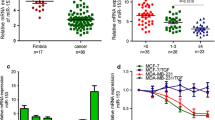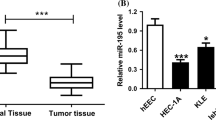Abstract
Distant metastasis is the predominant site of gastric cancer recurrence and the most common cause of death. Recently, accumulating evidence has established that aberrant epithelial-mesenchymal transition activation plays a crucial role in the genesis, invasion, and metastasis of various cancers, including breast cancer. In this paper, we found that miR-137, which has been reported to function as a tumor suppressor in a variety of cancers, could significantly suppress the migration and invasion of MCF-7 cells, which might be correlated with its suppressive effects on the EMT procedure. Upon transfection, the epithelial marker, E-cadherin, was up-regulated, and the mesenchymal markers, N-cadherin and Vimentin, were suppressed. Moreover, we also found that carboxyl-terminal binding protein 1 (CtBP1) was a putative target gene of miR-137 in MCF-7 cells, and might be involved in the suppressive effects, which might provide novel diagnostic and therapeutic options for human breast cancer in the future.




Similar content being viewed by others
References
DeSantis C, Ma J, Bryan L, Jemal A. Breast cancer statistics, 2013. CA Cancer J Clin. 2014;64(1):52–62. doi:10.3322/caac.21203.
Gatza ML, Lucas JE, Barry WT, Kim JW, Wang Q, Crawford MD, et al. A pathway-based classification of human breast cancer. Proc Natl Acad Sci USA. 2010;107(15):6994–9. doi:10.1073/pnas.0912708107.
Thiery JP, Acloque H, Huang RY, Nieto MA. Epithelial–mesenchymal transitions in development and disease. Cell. 2009;139(5):871–90. doi:10.1016/j.cell.2009.11.007.
Kalluri R, Weinberg RA. The basics of epithelial-mesenchymal transition. J Clin Investig. 2009;119(6):1420–8. doi:10.1172/jci39104.
Christiansen JJ, Rajasekaran AK. Reassessing epithelial to mesenchymal transition as a prerequisite for carcinoma invasion and metastasis. Cancer Res. 2006;66(17):8319–26. doi:10.1158/0008-5472.can-06-0410.
Klymkowsky MW, Savagner P. Epithelial–mesenchymal transition: a cancer researcher’s conceptual friend and foe. Am J Pathol. 2009;174(5):1588–93. doi:10.2353/ajpath.2009.080545.
Montemayor-Garcia C, Hardin H, Guo Z, Larrain C, Buehler D, Asioli S, et al. The role of epithelial mesenchymal transition markers in thyroid carcinoma progression. Endocr Pathol. 2013;24(4):206–12. doi:10.1007/s12022-013-9272-9.
Liang Q, Li L, Zhang J, Lei Y, Wang L, Liu DX, et al. CDK5 is essential for TGF-beta1-induced epithelial-mesenchymal transition and breast cancer progression. Sci Rep. 2013;3:2932. doi:10.1038/srep02932.
Vincent-Salomon A, Thiery JP. Host microenvironment in breast cancer development: epithelial-mesenchymal transition in breast cancer development. Breast Cancer Res. 2003;5(2):101–6.
Hirohashi S. Inactivation of the E-cadherin-mediated cell adhesion system in human cancers. Am J Pathol. 1998;153(2):333–9. doi:10.1016/s0002-9440(10)65575-7.
Garg M. Targeting microRNAs in epithelial-to-mesenchymal transition-induced cancer stem cells: therapeutic approaches in cancer. Expert Opin Ther Targets. 2015;19(2):285–97. doi:10.1517/14728222.2014.975794.
Balaguer F, Link A, Lozano JJ, Cuatrecasas M, Nagasaka T, Boland CR, et al. Epigenetic silencing of miR-137 is an early event in colorectal carcinogenesis. Cancer Res. 2010;70(16):6609–18. doi:10.1158/0008-5472.can-10-0622.
Chen X, Wang J, Shen H, Lu J, Li C, Hu DN, et al. Epigenetics, microRNAs, and carcinogenesis: functional role of microRNA-137 in uveal melanoma. Invest Ophthalmol Vis Sci. 2011;52(3):1193–9. doi:10.1167/iovs.10-5272.
Zhao Y, Li Y, Lou G, Zhao L, Xu Z, Zhang Y, et al. miR-137 targets estrogen-related receptor alpha and impairs the proliferative and migratory capacity of breast cancer cells. PLoS ONE. 2012;7(6):e39102. doi:10.1371/journal.pone.0039102.
Zhu X, Li Y, Shen H, Li H, Long L, Hui L, et al. miR-137 restoration sensitizes multidrug-resistant MCF-7/ADM cells to anticancer agents by targeting YB-1. Acta Biochim Biophys Sin. 2013;45(2):80–6. doi:10.1093/abbs/gms099.
Chinnadurai G. The transcriptional corepressor CtBP: a foe of multiple tumor suppressors. Cancer Res. 2009;69(3):731–4. doi:10.1158/0008-5472.can-08-3349.
Deng Y, Deng H, Bi F, Liu J, Bemis LT, Norris D, et al. MicroRNA-137 targets carboxyl-terminal binding protein 1 in melanoma cell lines. Int J Biol Sci. 2011;7(1):133–7.
Thiery JP, Sleeman JP. Complex networks orchestrate epithelial-mesenchymal transitions. Nat Rev Mol Cell Biol. 2006;7(2):131–42. doi:10.1038/nrm1835.
Kong YW, Ferland-McCollough D, Jackson TJ, Bushell M. microRNAs in cancer management. Lancet Oncol. 2012;13(6):e249–58. doi:10.1016/s1470-2045(12)70073-6.
Bartel DP. MicroRNAs: genomics, biogenesis, mechanism, and function. Cell. 2004;116(2):281–97.
Chen K, Rajewsky N. The evolution of gene regulation by transcription factors and microRNAs. Nat Rev Genet. 2007;8(2):93–103. doi:10.1038/nrg1990.
Liu M, Lang N, Qiu M, Xu F, Li Q, Tang Q, et al. miR-137 targets Cdc42 expression, induces cell cycle G1 arrest and inhibits invasion in colorectal cancer cells. Int J Cancer. 2011;128(6):1269–79. doi:10.1002/ijc.25452.
Bi Y, Han Y, Bi H, Gao F, Wang X. miR-137 impairs the proliferative and migratory capacity of human non-small cell lung cancer cells by targeting paxillin. Hum Cell. 2014;27(3):95–102. doi:10.1007/s13577-013-0085-4.
Subramanian T, La Regina M, Chinnadurai G. Enhanced ras oncogene mediated cell transformation and tumorigenesis by adenovirus 2 mutants lacking the C-terminal region of E1a protein. Oncogene. 1989;4(4):415–20.
Frisch SM. Antioncogenic effect of adenovirus E1A in human tumor cells. Proc Natl Acad Sci USA. 1991;88(20):9077–81.
Grooteclaes ML, Frisch SM. Evidence for a function of CtBP in epithelial gene regulation and anoikis. Oncogene. 2000;19(33):3823–8. doi:10.1038/sj.onc.1203721.
Acknowledgments
This research was supported through the Fundamental Research Funds for the National Natural Science Foundation of China (30972932, 81173601).
Author information
Authors and Affiliations
Corresponding author
Ethics declarations
Conflict of interest
None declared.
Additional information
Y. Han and Y. Bi contributed equally to this work.
Rights and permissions
About this article
Cite this article
Han, Y., Bi, Y., Bi, H. et al. miR-137 suppresses the invasion and procedure of EMT of human breast cancer cell line MCF-7 through targeting CtBP1 . Human Cell 29, 30–36 (2016). https://doi.org/10.1007/s13577-015-0124-4
Received:
Accepted:
Published:
Issue Date:
DOI: https://doi.org/10.1007/s13577-015-0124-4




